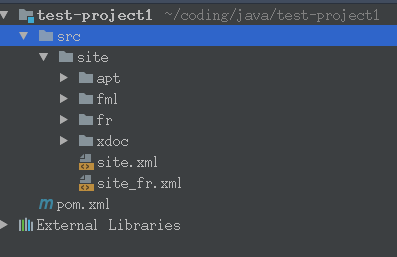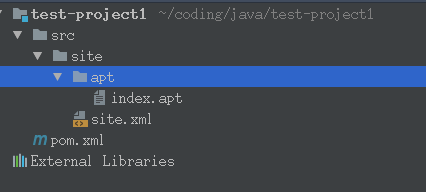Maven介绍,包括作用、核心概念、用法、常用命令、扩展及配置
http://www.trinea.cn/android/maven/
Maven库:
http://repo2.maven.org/maven2/
Maven依赖查询:
http://mvnrepository.com/
【Maven常用命令】(转自:http://www.cnblogs.com/kingfy/p/5665218.html)
1. 创建Maven的普通java项目:
有下面几种不同的DarchetypeArtifactId
1.省略默认是maven-archetype-quickstart
mvn archetype:generate -DgroupId=com.xxxx.xxxx -DartifactId=test-project -DarchetypeCatalog=internal -DarchetypeArtifactId=maven-archetype-quickstart
工程目录结构

2.maven-archetype-archetype 包含一个archetype的例子,主要用于当我们要建立自己的archetype的时候
工程目录结构

3.maven-archetype-j2ee-simple 包含一个简单的j2ee应用的例子
工程目录结构

4.maven-archetype-plugin 包含一个Maven plugin的例子
工程目录结构

5.maven-archetype-plugin-site 包含一个Maven plugin site的例子
6.Maven-archetype-portlet 包含一个portlet的例子
打包失败
7.maven-archetype-simple 包含一个简单maven项目
创建失败
8.Maven-archetype-site 包含一个maven site的例子,它能够展示一些支持的文档类型,包括APT、XDoc和FML
工程结构目录

9.Maven-archetype-site-simple 包含一个maven site的例子
工程目录结构

2. 创建Maven的Web项目:
mvn archetype:create
-DgroupId=packageName
-DartifactId=webappName
-DarchetypeArtifactId=maven-archetype-webapp
3. 清理编译:mvn clean compile
4. 清理测试:mvn clean test
5. 清理打包:mvn clean package
6. 带有依赖打包:mvn package assembly:single
7.指定编译版本的打包:mvn package -Dmaven.test.skip=true -Dmaven.compiler.source=1.8 -Dmaven.compiler.target=1.8
8. 清理安装,会安装到~/.m2/目录下面:mvn clean install
9. 生成eclipse项目:mvn eclipse:eclipse
10. 生成idea项目:mvn idea:idea
12. 编译测试的内容:mvn test-compile
13. 只打jar包: mvn jar:jar
14. 跳过测试: mvn install -Dmaven.test.skip=true
15. 指定端口: mvn -Dmaven.tomcat.port=9090
16. 只测试而不编译,也不测试编译:mvn test -skipping compile -skipping test-compile ( -skipping 的灵活运用,当然也可以用于其他组合命令)
17. 清除eclipse的一些系统设置: mvn eclipse:clean
18.打包依赖:mvn assembly:assembly,使用后执行成功后会在target文件夹下多出一个以-jar-with-dependencies结尾的JAR包. 这个JAR包就包含了项目所依赖的所有JAR的CLASS.
通过cvs或svn下载代码到本机,然后执行mvn eclipse:eclipse生成ecllipse项目文件,然后导入到eclipse就行了;修改代码后执行mvn compile或mvn test检验,也可以下载eclipse的maven插件。
发布第三方Jar到本地库中: mvn install:install-file -DgroupId=com -DartifactId=client -Dversion=0.1.0 -Dpackaging=jar -Dfile=d:client-0.1.0.jar。
19.添加 jar 包到本地仓库
mvn install:install-file
-DgroupId=xxx
-DartifactId=xxx
-Dversion=1.0 //版本号
-Dpackaging=jar //类型
-Dfile=d:xxx-1.0.jar //jar实际路径
mvn install:install-file -Dfile=jar包的位置 -DgroupId=上面的groupId -DartifactId=上面的artifactId -Dversion=上面的version -Dpackaging=jar
20.如果遇到mvn package 内存爆掉的情况,增加内存,然后mvn -version查看内存是多少
export MAVEN_OPTS="-Xmx512m -XX:MaxPermSize=128m"
添加打包插件:
<plugin>
<artifactId>maven-compiler-plugin</artifactId>
<configuration>
<source>1.6</source>
<target>1.6</target>
<encoding>UTF-8</encoding>
<compilerArguments>
<extdirs>srcmainwebappWEB-INFlib</extdirs>
</compilerArguments>
</configuration>
</plugin>
【库版本选择】
<dependency>
<groupId>org.codehaus.plexus</groupId>
<artifactId>plexus-utils</artifactId>
<version>[1.1,)</version>
</dependency>
表达式 含义
(,1.0] version<=1.0
[1.2,1.3]
1.2<=version<=1.3
[1.0,2.0)
1.0<=version<2.0
[1.5,) 1.5<=version
(,1.1),(1.1,) version!=1.1
【pom.xml 基本节点】
<project> 根节点
<modelversion> pom.xml
使用的对象模型版本
<groupId> 创建项目的组织或团体的唯一
Id
<artifactId> 项目唯一Id,
项目名
<packaging>
打包扩展名(JAR、WAR、EAR)
<version> 项目版本号
<name> 显示名,用于生成文档
<url> 组织站点,用于生成文档
<description>
项目描述,用于生成文档
<dependency>之<scope>
管理依赖部署
<scope> 可使用 5 个值:
compile 缺省值,用于所有阶段,随项目一起发布
provided 期望JDK、容器或使用者提供此依赖。如servlet.jar
runtime 只在运行时使用
test 只在测试时使用,不随项目发布
system 需显式提供本地jar,不在代码仓库中查找
自用maven的setting.xml配置文件
<?xml version="1.0" encoding="UTF-8"?>
<!--
Licensed to the Apache Software Foundation (ASF) under one
or more contributor license agreements. See the NOTICE file
distributed with this work for additional information
regarding copyright ownership. The ASF licenses this file
to you under the Apache License, Version 2.0 (the
"License"); you may not use this file except in compliance
with the License. You may obtain a copy of the License at
http://www.apache.org/licenses/LICENSE-2.0
Unless required by applicable law or agreed to in writing,
software distributed under the License is distributed on an
"AS IS" BASIS, WITHOUT WARRANTIES OR CONDITIONS OF ANY
KIND, either express or implied. See the License for the
specific language governing permissions and limitations
under the License.
-->
<!--
| This is the configuration file for Maven. It can be specified at two levels:
|
| 1. User Level. This settings.xml file provides configuration for a single user,
| and is normally provided in ${user.home}/.m2/settings.xml.
|
| NOTE: This location can be overridden with the CLI option:
|
| -s /path/to/user/settings.xml
|
| 2. Global Level. This settings.xml file provides configuration for all Maven
| users on a machine (assuming they're all using the same Maven
| installation). It's normally provided in
| ${maven.home}/conf/settings.xml.
|
| NOTE: This location can be overridden with the CLI option:
|
| -gs /path/to/global/settings.xml
|
| The sections in this sample file are intended to give you a running start at
| getting the most out of your Maven installation. Where appropriate, the default
| values (values used when the setting is not specified) are provided.
|
|-->
<settings xmlns="http://maven.apache.org/SETTINGS/1.0.0"
xmlns:xsi="http://www.w3.org/2001/XMLSchema-instance"
xsi:schemaLocation="http://maven.apache.org/SETTINGS/1.0.0 http://maven.apache.org/xsd/settings-1.0.0.xsd">
<!-- localRepository
| The path to the local repository maven will use to store artifacts.
|
| Default: ${user.home}/.m2/repository
<localRepository>/path/to/local/repo</localRepository>
-->
<!-- interactiveMode
| This will determine whether maven prompts you when it needs input. If set to false,
| maven will use a sensible default value, perhaps based on some other setting, for
| the parameter in question.
|
| Default: true
<interactiveMode>true</interactiveMode>
-->
<!-- offline
| Determines whether maven should attempt to connect to the network when executing a build.
| This will have an effect on artifact downloads, artifact deployment, and others.
|
| Default: false
<offline>false</offline>
-->
<!-- pluginGroups
| This is a list of additional group identifiers that will be searched when resolving plugins by their prefix, i.e.
| when invoking a command line like "mvn prefix:goal". Maven will automatically add the group identifiers
| "org.apache.maven.plugins" and "org.codehaus.mojo" if these are not already contained in the list.
|-->
<pluginGroups>
<!-- pluginGroup
| Specifies a further group identifier to use for plugin lookup.
<pluginGroup>com.your.plugins</pluginGroup>
-->
</pluginGroups>
<!-- proxies
| This is a list of proxies which can be used on this machine to connect to the network.
| Unless otherwise specified (by system property or command-line switch), the first proxy
| specification in this list marked as active will be used.
|-->
<proxies>
<!-- proxy
| Specification for one proxy, to be used in connecting to the network.
|
<proxy>
<id>optional</id>
<active>true</active>
<protocol>http</protocol>
<username>proxyuser</username>
<password>proxypass</password>
<host>proxy.host.net</host>
<port>80</port>
<nonProxyHosts>local.net|some.host.com</nonProxyHosts>
</proxy>
-->
</proxies>
<!-- servers
| This is a list of authentication profiles, keyed by the server-id used within the system.
| Authentication profiles can be used whenever maven must make a connection to a remote server.
|-->
<servers>
<!-- server
| Specifies the authentication information to use when connecting to a particular server, identified by
| a unique name within the system (referred to by the 'id' attribute below).
|
| NOTE: You should either specify username/password OR privateKey/passphrase, since these pairings are
| used together.
|
<server>
<id>deploymentRepo</id>
<username>repouser</username>
<password>repopwd</password>
</server>
-->
<!-- Another sample, using keys to authenticate.
<server>
<id>siteServer</id>
<privateKey>/path/to/private/key</privateKey>
<passphrase>optional; leave empty if not used.</passphrase>
</server>
-->
<server>
<id>nexus-releases</id>
<username>admin</username>
<password>xxx</password>
</server>
<server>
<id>nexus-snapshots</id>
<username>admin</username>
<password>xxx</password>
</server>
</servers>
<!-- mirrors
| This is a list of mirrors to be used in downloading artifacts from remote repositories.
|
| It works like this: a POM may declare a repository to use in resolving certain artifacts.
| However, this repository may have problems with heavy traffic at times, so people have mirrored
| it to several places.
|
| That repository definition will have a unique id, so we can create a mirror reference for that
| repository, to be used as an alternate download site. The mirror site will be the preferred
| server for that repository.
|-->
<mirrors>
<!--tencent-->
<mirror>
<id>mynexus</id>
<mirrorOf>mynexus</mirrorOf>
<name>My Nexus</name>
<url>http://tencent:40000/nexus/content/repositories/thirdparty/</url>
</mirror>
<!--默认的中央仓库-->
<mirror>
<id>repo2</id>
<mirrorOf>central</mirrorOf>
<name>Human Readable Name for this Mirror.</name>
<url>http://repo2.maven.org/maven2/</url>
</mirror>
<!--aliyun-->
<mirror>
<id>nexus-aliyun</id>
<mirrorOf>aliyun</mirrorOf>
<name>Nexus aliyun</name>
<url>http://maven.aliyun.com/nexus/content/groups/public</url>
</mirror>
<mirror>
<id>ui</id>
<mirrorOf>ui</mirrorOf>
<name>Human Readable Name for this Mirror.</name>
<url>http://uk.maven.org/maven2/</url>
</mirror>
<mirror>
<id>ibiblio</id>
<mirrorOf>ibiblio</mirrorOf>
<name>Human Readable Name for this Mirror.</name>
<url>http://mirrors.ibiblio.org/pub/mirrors/maven2/</url>
</mirror>
<!-- mirror
| Specifies a repository mirror site to use instead of a given repository. The repository that
| this mirror serves has an ID that matches the mirrorOf element of this mirror. IDs are used
| for inheritance and direct lookup purposes, and must be unique across the set of mirrors.
|
<mirror>
<id>mirrorId</id>
<mirrorOf>repositoryId</mirrorOf>
<name>Human Readable Name for this Mirror.</name>
<url>http://my.repository.com/repo/path</url>
</mirror>
-->
</mirrors>
<!-- profiles
| This is a list of profiles which can be activated in a variety of ways, and which can modify
| the build process. Profiles provided in the settings.xml are intended to provide local machine-
| specific paths and repository locations which allow the build to work in the local environment.
|
| For example, if you have an integration testing plugin - like cactus - that needs to know where
| your Tomcat instance is installed, you can provide a variable here such that the variable is
| dereferenced during the build process to configure the cactus plugin.
|
| As noted above, profiles can be activated in a variety of ways. One way - the activeProfiles
| section of this document (settings.xml) - will be discussed later. Another way essentially
| relies on the detection of a system property, either matching a particular value for the property,
| or merely testing its existence. Profiles can also be activated by JDK version prefix, where a
| value of '1.4' might activate a profile when the build is executed on a JDK version of '1.4.2_07'.
| Finally, the list of active profiles can be specified directly from the command line.
|
| NOTE: For profiles defined in the settings.xml, you are restricted to specifying only artifact
| repositories, plugin repositories, and free-form properties to be used as configuration
| variables for plugins in the POM.
|
|-->
<profiles>
<!-- profile
| Specifies a set of introductions to the build process, to be activated using one or more of the
| mechanisms described above. For inheritance purposes, and to activate profiles via <activatedProfiles/>
| or the command line, profiles have to have an ID that is unique.
|
| An encouraged best practice for profile identification is to use a consistent naming convention
| for profiles, such as 'env-dev', 'env-test', 'env-production', 'user-jdcasey', 'user-brett', etc.
| This will make it more intuitive to understand what the set of introduced profiles is attempting
| to accomplish, particularly when you only have a list of profile id's for debug.
|
| This profile example uses the JDK version to trigger activation, and provides a JDK-specific repo.
<profile>
<id>jdk-1.4</id>
<activation>
<jdk>1.4</jdk>
</activation>
<repositories>
<repository>
<id>jdk14</id>
<name>Repository for JDK 1.4 builds</name>
<url>http://www.myhost.com/maven/jdk14</url>
<layout>default</layout>
<snapshotPolicy>always</snapshotPolicy>
</repository>
</repositories>
</profile>
-->
<!--
| Here is another profile, activated by the system property 'target-env' with a value of 'dev',
| which provides a specific path to the Tomcat instance. To use this, your plugin configuration
| might hypothetically look like:
|
| ...
| <plugin>
| <groupId>org.myco.myplugins</groupId>
| <artifactId>myplugin</artifactId>
|
| <configuration>
| <tomcatLocation>${tomcatPath}</tomcatLocation>
| </configuration>
| </plugin>
| ...
|
| NOTE: If you just wanted to inject this configuration whenever someone set 'target-env' to
| anything, you could just leave off the <value/> inside the activation-property.
|
<profile>
<id>env-dev</id>
<activation>
<property>
<name>target-env</name>
<value>dev</value>
</property>
</activation>
<properties>
<tomcatPath>/path/to/tomcat/instance</tomcatPath>
</properties>
</profile>
-->
<!--配置私服-->
<profile>
<id>nexus</id>
<repositories>
<repository>
<id>public</id>
<name>Public Repositories</name>
<url>http://tencent:40000/nexus/content/repositories/thirdparty</url>
</repository>
</repositories>
<pluginRepositories>
<pluginRepository>
<id>public</id>
<name>Public Repositories</name>
<url>http://tencent:40000/nexus/content/repositories/thirdparty</url>
</pluginRepository>
</pluginRepositories>
</profile>
</profiles>
<activeProfiles>
<activeProfile>nexus</activeProfile>
</activeProfiles>
<!-- activeProfiles
| List of profiles that are active for all builds.
|
<activeProfiles>
<activeProfile>alwaysActiveProfile</activeProfile>
<activeProfile>anotherAlwaysActiveProfile</activeProfile>
</activeProfiles>
-->
</settings>